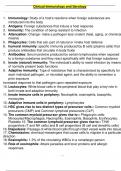Clinical Immunology and Serology
1. Immunology: Study of a host's reactions when foreign substances are
introduced into the body
2. Antigens: Foreign substances that induce a host response
3. Immunity: The condition of being resistant to infection
4. Attenuation: Change- make a pathogen less virulent (heat, aging, or chemical
means)
5. Phagocytes: Cells that eat- part of natural or innate host defense
6. humoral immunity: specific immunity produced by B cells (plasma cells) that
produce antibodies that circulate in body fluids
7. Antibodies: Serum proteins produced by certain lymphocytes when exposed
to a foreign substance and they react specifically with that foreign substance
8. Innate (natural) immunity: The individual's ability to resist infection by means
of normally present body functions
9. Adaptive immunity: Type of resistance that is characterized by specificity for
each individual pathogen, or microbial agent, and the ability to remember a
prior exposure
increased response to that pathogen upon repeated exposure
10. Leukocytes: White blood cells in the peripheral blood that play a key role in
both innate and adaptive immunity
11. Innate immune cells in periphery: Neutrophils, eosinophils, basophils,
monocytes
12. Adaptive immune cells in periphery: Lymphocytes
13. HSC gives rise to two distinct types of precursor cells:: Common myeloid
precursors (CMP) and Common lymphoid precursors (CLP)
14. The common myeloid precursor gives rise to:: Phagocytic cells:
Monocytes/Macrophages, Neutrophils, Eosinophils, Basophils, Erythrocytes,
Platelets 15. The common lymphoid precursor gives rise to:: T/NK
progenitors (T and NK cells) and B cell progenitors (B cell and dendritic cells)
16. Diapedesis: Passage of white blood cells through intact vessel walls into tissue
17. Chemotaxins: chemical messengers that cause cells to migrate in a particular
direction
18. Eosinophils: 1-3% of the circulating WBCs in a nonallergic person
19. Role of eosinophils: Attack parasites and toxic proteins and allergic
responses.
, Clinical Immunology and Serology
Regulation of mast cell function
20. Basophil granules: histamine, cytokines, growth factors, and heparin
21. Basophil function: Regulate T helper cell responses and stimulate B cells to
produce IgE
22. Monocytes: Largest cells in peripheral blood 4-10% of total circulating WBCs
up to 30h and migrate into tissue to become macrophages
23. Macrophages: Tissue monocytes
Contain no peroxidase
Named according to a tissue location
Lifespan- months
24. Macrophage role: Microbial killing, anti-tumor activity, intracellular parasite
eradication, phagocytosis, secretion cell mediators
Present antigens to T and B cells
25. Cytokines: Released by T lymphocytes during immune response
Chemical messengers which enhance macrophage killing activity
26. Mast cell role: Allergic reactions
Antigen-presenting cells
Enhance and suppress the adaptive immune response
27. Dendritic cells: Phagocytosis
Antigen-presenting cells
28. Clusters of Differentiation (CD): - Surface proteins
- Act as markers of recognition for lymphocytes
29. B Cells: Bone marrow
Membrane-bound antibodies: IgM and IgD
Surface proteins CD19, CD21, MHC class II
30. Thymocytes: Lymphocyte precursors; enter the thymus from the bone
marrow
31. 3 types of T cells: helper, cytotoxic, regulatory
32. CD4 receptor: helper or regulatory
33. CD8 receptor: cytotoxic
34. NK cells: Kill target cells without prior exposure first line of defense against
cell that are virally infected, cells infected with other intracellular pathogens,




